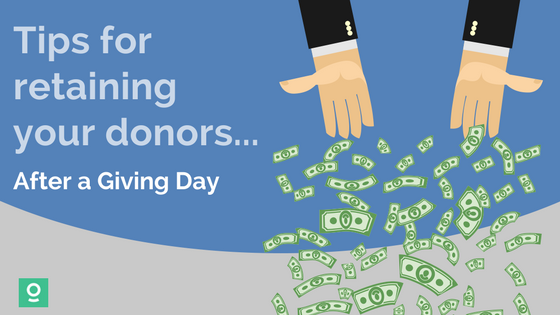
Participating in a 24-hour online giving event like Giving Tuesday or Give Local America is a great opportunity for your organization to raise funds. To fully harness its power, though, it’s important to look beyond the day itself!
If your Giving Day is a community-wide event, the added publicity can really help drive new donors to donate to your nonprofit. Making a plan for your Giving Day is the key to success, and there are lots of helpful planning guides available online to help you prepare for and promote your upcoming Giving Day (check out, for example, this Giving Day Communications Plan from Give Local America).
With all the effort you put into preparations, you may feel like your work is done when the clock strikes midnight at the close of your Giving Day. But if you want to retain your donors, especially those first-time donors, the work is just beginning. According to the Fundraising Effectiveness Project, only 19 percent of new donors will make another contribution. That’s not an encouraging number, but the good news is that fundraisers can take clear steps to boost that retention rate.
Your Giving Day plan should include action items for at least a month beyond the day itself. Incorporate follow-up into your overall plan, and be sure to have some targeted strategies to engage your first-time donors.
First things first: You can’t follow up with donors if you don’t know how to reach them. Whether your Giving Day is hosted by a community foundation or another sponsoring organization, or you’re running your own Giving Day through a crowdfunding platform, make sure you know:
- How to access donor information
- What information will be available to you (some companies may give you access only to names and email addresses, rather than mailing addresses)
- In what format it will be available, such as an Excel file (If you’re using a donor management system like Little Green Light, you can easily upload that file into your database.)
Once you know how to access and store the contact information for your Giving Day donors, you can start planning how to engage with them.
Here are our suggestions for your follow-up plan:
- Send an immediate thank you. Your donors most likely received an emailed receipt when they made their contribution, but you need to go beyond that generic notification. Share results of the Giving Day and describe how the funds will be used. Make it a donor-centered thank you letter, and your donors will be especially pleased. You can craft the majority of this letter well in advance of the Giving Day, and fill in the specifics once the Giving Day is completed. That way, you’ll be ready to generate those thank you letters quickly and get them in the mail! Plan to send them the day after your Giving Day, or at least in the same week. For your first-time donors: Include some welcome materials that introduce your organization’s mission, demonstrate the impact that donors have, and share some success stories. We offer tips for how to do that here.
- Report back. Your thank you letter shared how the Giving Day funds will be used. Within a month or two, send another communication to update your donors. Provide at least one specific example of what their Giving Day donation is making possible. For your first-time donors: Edit your letter or add a handwritten note to first-time donors that thanks them again for becoming a donor—you want them to feel welcomed!
- Ongoing communication. Make sure all your Giving Day donors are included in your regular mailings and email communications. Regular, consistent communication will help them keep your organization top of mind and remind them of how satisfying it was to support your mission. For your first-time donors: If you’re sending out a regular newsletter, consider adding a lift note thanking the donor for their Giving Day donation and telling them you hope they’ll enjoy the newsletter.
- Ask again! Once you have thoroughly thanked, reported to, and communicated with your Giving Day donors, you can include them in an appeal solicitation. Most donors won’t give unless they’re asked, so don’t assume that they’ll make a repeat contribution on their own. Give them the opportunity to invest in your organization’s work again. For your first-time donors: Segment your appeal so that your letter to first-time donors references their Giving Day donation and reinforces how much your organization appreciated that gift.
When you approach your Giving Day with a plan that extends beyond the day itself, your organization can leverage the impact of the Giving Day to retain donors and build over the long term. With your well-executed post–Giving Day strategy, your donors may find it hard to resist making another contribution!
